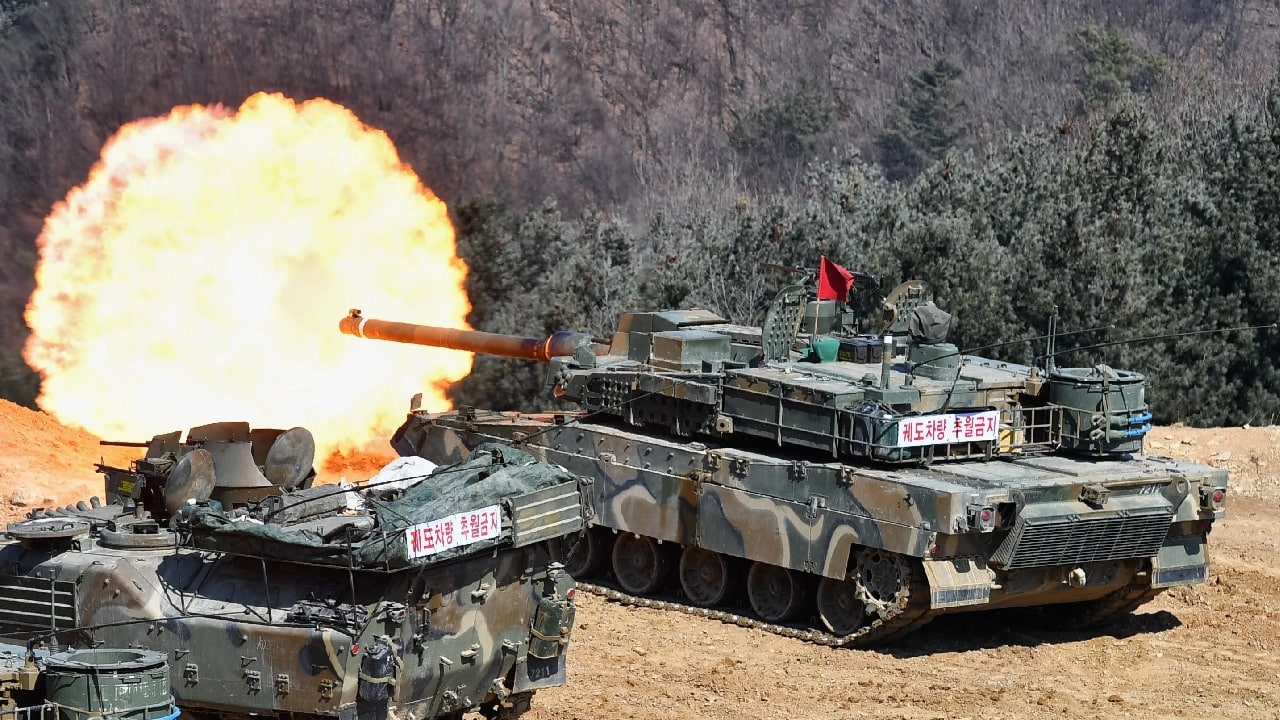Sure, the K2 Black Panther is not a well-known tank outside of defense and land forces circles around the world. And yet, this tank is always mentioned as being one of the very best on Earth. And it would need to be, as it would be facing thousands of North Korean armored vechciles if the Korean War ever resumed: During the Korean War, the first tanks deployed by the United Nations forces were the American M24 Chaffee light tanks. Not unexpectedly the M24s fared poorly against North Korea’s Soviet-built T-35-85s. Following the war, the South Korean military bolstered its armored fleet with a variety of U.S.-made tanks but attempts made to obtain the M60A1 Patton main battle tanks (MBTs) in the 1970s ended in failure.
Always fearing that its neighbor to the north would launch an attack across the DMZ, South Korea took matters into its own hands and developed a domestically produced tank – the K1, which was based on the early designs of the American XM1 program that led to the development of the M1 Abrams. The new South Korean-made tank entered service in the late-1980s and has been steadily improved, with the K1A2 entering service in 2013.
However, Seoul has moved forward with an entirely new design: the K2 Black Panther, a next-generation MBT developed by the South Korean Agency for Defense Development and manufactured by Hyundai Rotem. The K2 was meant to complement – rather than replace – the K1 series that are currently fielded by the South Korean military.
The K2 was developed utilizing indigenous technology only, and the first prototype was unveiled in 2007, while production commenced for the first 100 K2 tanks in 2014. It is considered one of the most advanced MBTs in the world, outclassing any tanks in service with North Korea or even China.
It relies on both an undisclosed modular composite armor and Explosive Reactive Armor (ERA) blocks, and according to reports can withstand direct hits to the front from a 120mm tank round. In addition, the K2 also is equipped with an active protection system as well as countermeasure systems that include NBC (nuclear-biological-chemical) protection.
Heavy Hitter
The K2 Black Panther MBT has a crew of three members including a commander, gunner, and driver. The MBT’s main armament is a Rheinmetall 120mm L/55 smoothbore gun, produced under license in South Korea and equipped with a domestically-designed automatic loader – which can ensure the loading of projectiles on the move including when on uneven surfaces. The 120mm gun can reportedly fire approximately 10 to 15 rounds per minute. It can be used with a variety of munitions and is compatible with all standard NATO tank rounds. The 120mm L/55 gun is also capable of firing the new KSTAM (Korean Smart Top-Attack Munition) rounds – smart target-activated fire-and-forget projectiles.
The secondary armament of the Black Panther includes a 12.7mm heavy machine gun and a 7.62mm machine gun.
South Korea’s next-generation tank is equipped with domestically-developed auto-target detection and tracking system, which incorporates a hunter-killer function. The tank also features an electric gun and turret driving system (28-260VDC) provided by Doosan Corporation Mottrol. In addition, the gunner’s primary sight (GPS) and commander’s panoramic sight (CPS) are stabilized in two axes and include a thermal imager and laser rangefinder enabling day/night observation.
Suspension System
While not as speedy as its namesake, the Black Panther can still hunt down its slower-moving prey thanks to its license-built MTU MB 883 Ka501 diesel engine, which produces 1,500 horsepower. It can reach a top speed of 43 mph on the road, and 31 mph cross country. There is also an auxiliary gas-turbine power unit, offering 400 horsepower.
The tank also is equipped with a unique suspension system, which can be contorted into a variety of positions. For cross-country performance, the suspension is raised, providing the K2 greater ground clearance, while on roads, the suspension is lowered, hugging the ground for better speed. In addition, the K2 can “lean,” “sit” or “kneel” to provide the main gun better maneuverability in hull-down positions.
When leaning backward, the K2 can raise its main gun to target low-flying aircraft, or to better target more highly elevated targets on Korean Peninsula’s hilly terrain. The K2 even has the ability to lean to the left or the right, which improves maneuverability when driving along slopes.
Exporting the Black Panther
Even as Seoul is currently adopting the tank for its domestic use, the tank has caught the eye of foreign buyers including the Norwegian Defence Materiel Agency (NDMA), which announced that it would put the K2 up against the German-made Leopard 2A7 in tests to determine Norway’s next MBT.
Last December, Cairo also announced that it was in negotiations with South Korea to co-produce a version of the Black Panther for use by the Egyptian Army. Trade between Egypt and South Korea has increased in recent years and reached nearly $2 billion in 2020 in engineering and electrical goods, furniture, clothes, chemical products, fertilizers, and medical industries. Seoul has also invested some $570 million into 181 projects in Egypt, including construction, information technology, tourism, and agriculture. Now Cairo is looking to Seoul for military hardware and that will likely include the K2 Black Panther.
Now a Senior Editor for 1945, Peter Suciu is a Michigan-based writer who has contributed to more than four dozen magazines, newspapers and websites. He regularly writes about military hardware, and is the author of several books on military headgear including A Gallery of Military Headdress, which is available on Amazon.com. Peter is also a Contributing Writer for Forbes.

